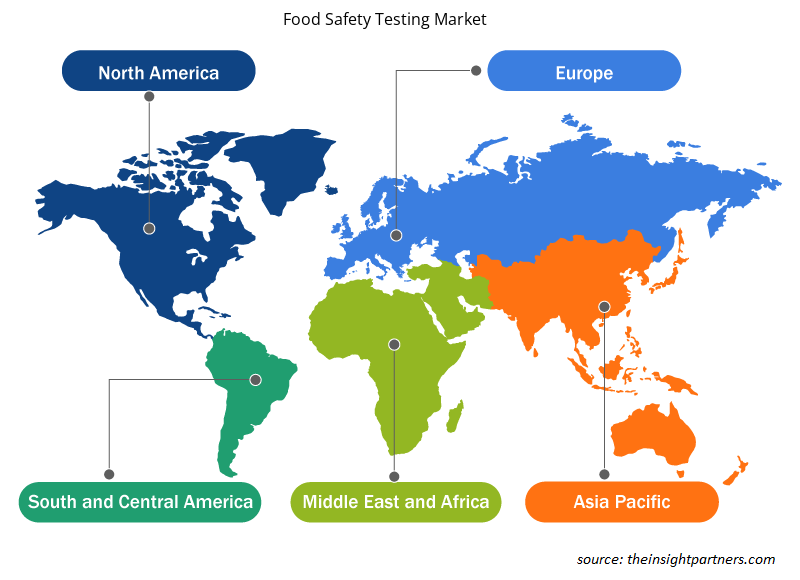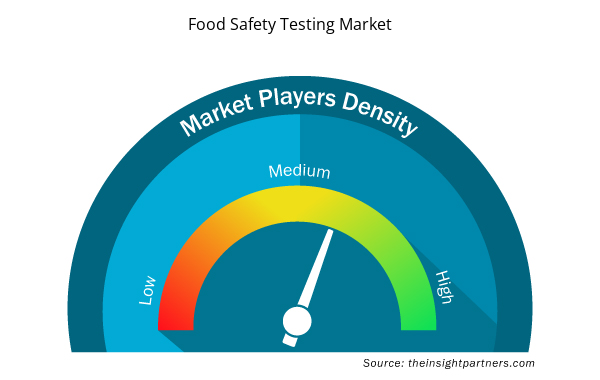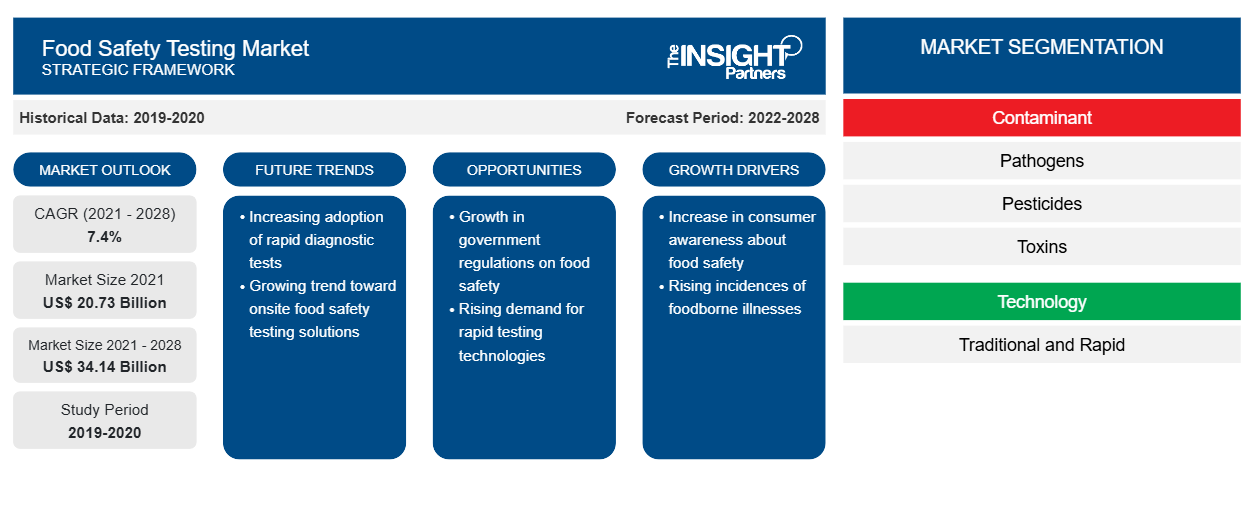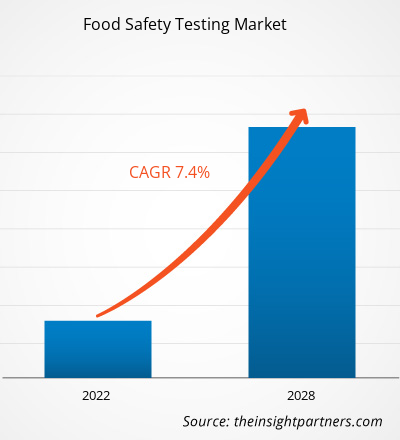بلغت قيمة سوق اختبار سلامة الأغذية 20,733.4 مليون دولار أمريكي في عام 2021 ومن المتوقع أن تصل إلى 34,142.5 مليون دولار أمريكي بحلول عام 2028؛ ومن المتوقع أن ينمو بمعدل نمو سنوي مركب قدره 7.4٪ من عام 2021 إلى عام 2028.
اختبار سلامة الغذاء هو تحليل علمي لمنتج غذائي ومحتوياته للعثور على معلومات حول خصائص مختلفة مثل الخصائص الفيزيائية والكيميائية والتركيب والبنية. تُستخدم المعلومات لتحديد سلامة المنتج للاستهلاك. يتطلب الانتشار المتزايد للأمراض المنقولة بالغذاء اختبار سلامة الغذاء لجميع منتجات الأغذية والمشروبات لمنع المخاطر الصحية، مما يعزز نمو سوق اختبار سلامة الغذاء.
وفقًا للبيانات التي نشرتها منظمة الصحة العالمية، فإن استهلاك الأغذية غير الآمنة يتسبب في وفاة 420.000 شخص و600 مليون حالة من الأمراض المنقولة بالغذاء في جميع أنحاء العالم كل عام. يمكن الوقاية من الأمراض المنقولة بالغذاء؛ وبالتالي، تقود العديد من المنظمات والحكومات إجراءات منسقة لبناء أنظمة سلامة غذائية مرنة وقوية عبر صناعات متعددة. علاوة على ذلك، قدر تقرير صادر عن البنك الدولي عام 2018 أن العبء الاقتصادي الناجم عن الخسارة الكلية للإنتاجية التي تواجهها الأمراض المنقولة بالغذاء يقدر بنحو 95.2 مليار دولار أمريكي سنويًا. لذلك، تشهد سوق اختبار سلامة الغذاء نموًا بسبب وعي المستهلك بشأن سلامة الغذاء وجهود الحكومة للوقاية من الأمراض المنقولة بالغذاء.
قم بتخصيص هذا التقرير ليناسب متطلباتك
ستحصل على تخصيص لأي تقرير - مجانًا - بما في ذلك أجزاء من هذا التقرير، أو تحليل على مستوى الدولة، وحزمة بيانات Excel، بالإضافة إلى الاستفادة من العروض والخصومات الرائعة للشركات الناشئة والجامعات
- احصل على أهم اتجاهات السوق الرئيسية لهذا التقرير.ستتضمن هذه العينة المجانية تحليلاً للبيانات، بدءًا من اتجاهات السوق وحتى التقديرات والتوقعات.
تأثير جائحة كوفيد-19 على سوق اختبارات سلامة الأغذية
إن وعي المستهلك هو أحد المحركات الرئيسية لسوق اختبار سلامة الأغذية في جميع أنحاء العالم. لقد أثر تفشي فيروس كورونا المستجد بشكل إيجابي على السوق حيث يركز المستهلكون والحكومات على سلامة ونظافة المنتجات المخصصة للاستهلاك. تواجه جميع قطاعات الأغذية والمشروبات تحديات وسط تفشي المرض حيث أن فيروس سارس-كوف-2 شديد العدوى ويمكن أن ينتقل عبر أسطح الطعام. واجهت مرافق معالجة اللحوم والدواجن تحديات مميزة فيما يتعلق بانتقال الفيروس حيث أصيب العمال في العديد من المرافق في جميع أنحاء العالم. على سبيل المثال، أفادت وزارة الصحة والخدمات الإنسانية الأمريكية في يوليو 2020 أن 239 منشأة في 23 ولاية تعرضت للإصابة بفيروس كورونا المستجد. بلغ إجمالي الحالات المبلغ عنها 16233 حالة، مع 86 حالة وفاة مرتبطة بها. علاوة على ذلك، في نوفمبر 2020، أفادت الصين أن عينة لحم خنزير مجمدة مستوردة في الصين تسببت في حالة إصابة جديدة بفيروس كورونا المستجد في البلاد. لقد خلقت مثل هذه الحالات من عدوى فيروس كورونا المستجد في صناعة الأغذية مخاوف بين المستهلكين والحكومات، مما دفع الطلب على اختبارات سلامة الأغذية للتخفيف من المخاطر الصحية.
رؤى السوق
ظهور حالات تفشي الأمراض المنقولة بالغذاء
الأمراض المنقولة بالغذاء سامة أو معدية. ويمكن أن تحدث بسبب المواد الكيميائية والطفيليات والفيروسات التي تدخل الجسم من خلال المياه أو الأغذية الملوثة. ويمكن أن تسبب مسببات الأمراض المنقولة بالغذاء عدوى منهكة، مثل التهاب السحايا أو الإسهال الشديد. وفي بعض الحالات، يمكن أن يسبب التلوث الكيميائي أمراضًا طويلة الأمد، مثل السرطان، أو مرضًا قصير الأمد، مثل التسمم الحاد. ومن الأمثلة القليلة على الأغذية غير الآمنة المحار النيئ الذي يحتوي على سموم بحرية، والخضروات والفواكه الملوثة بالبراز، والأطعمة غير المطبوخة ذات الأصل الحيواني. تعد الإشريكية القولونية، والكامبيلوباكتر، والسالمونيلا من بين أكثر مسببات الأمراض المنقولة بالغذاء شيوعًا والتي تؤثر على ملايين الأشخاص في جميع أنحاء العالم سنويًا وتؤدي إلى نتائج مميتة أو شديدة. ومن بين أعراض الأمراض المنقولة بالغذاء الإسهال وآلام البطن والقيء والغثيان والصداع والحمى. علاوة على ذلك، تؤدي عدوى الليستيريا إلى وفاة الأطفال حديثي الولادة أو الإجهاض لدى النساء الحوامل. وعلى الرغم من أن فرص الإصابة بهذا المرض منخفضة نسبيًا، فإن الوفيات الناجمة عن الليستيريا تجعلها واحدة من أخطر الأمراض المنقولة بالغذاء. تنتقل عدوى ضمة الكوليرا إلى الإنسان من خلال الطعام أو الماء الملوث. وقد تشمل أعراضها الجفاف الشديد والإسهال المائي الشديد والقيء وآلام البطن وقد تؤدي إلى الوفاة. وقد ثبت أن أنواعًا مختلفة من المأكولات البحرية وعصيدة الدخن والخضروات والأرز متورطة في تفشي الكوليرا. لذلك، يتزايد الطلب على اختبارات سلامة الأغذية لمنع حدوث الأمراض المنقولة عن طريق الأغذية.
رؤى الملوثات
بناءً على الملوثات، يتم تقسيم سوق اختبار سلامة الأغذية إلى مسببات الأمراض والمبيدات الحشرية والسموم والكائنات المعدلة وراثيًا وغيرها. شكلت شريحة مسببات الأمراض أكبر حصة سوقية في عام 2020، ومن المتوقع أن تسجل شريحة الكائنات المعدلة وراثيًا أعلى معدل نمو سنوي مركب في السوق خلال فترة التنبؤ. يتم إجراء اختبار مسببات الأمراض للقضاء على أو تقليل حدوث الأمراض المنقولة بالغذاء. يعتبر القضاء ضروريًا للغاية بحيث يتم تنفيذ عملية الاختبار في نفس خطوة إنتاج الغذاء لضمان سلامة الغذاء والصرف الصحي. بعض مسببات الأمراض الأكثر شيوعًا التي يمكن أن تسبب أمراضًا منقولة بالغذاء هي الإشريكية القولونية والليستيريا والسالمونيلا. يمكن إجراء اختبار مسببات الأمراض باستخدام التقنيات التقليدية أو الأحدث. تستخدم التقنيات التقليدية معايير زراعة الخلايا التقليدية، في حين تشمل التقنيات الأحدث التشخيصات القائمة على الليزر أو القياس الطيفي. نظرًا لأن مسببات الأمراض هي واحدة من أكثر الأسباب شيوعًا للأمراض المنقولة بالغذاء، فإن شريحة مسببات الأمراض تمتلك أكبر حصة سوقية في سوق اختبار سلامة الأغذية. ومن المتوقع أيضًا أن ينمو سوق هذا القطاع خلال الفترة المتوقعة بسبب نمو صناعة الأغذية والمشروبات.
رؤى التكنولوجيا
بناءً على التكنولوجيا، ينقسم سوق اختبار سلامة الأغذية إلى تقليدي وسريع. استحوذ القطاع السريع على حصة سوقية أكبر في عام 2020، ومن المتوقع أن يسجل نفس القطاع معدل نمو سنوي مركب أعلى في السوق خلال فترة التنبؤ. يقدم كبار اللاعبين في السوق منتجات مبتكرة في الاختبار السريع نظرًا للطلب المرتفع على الخدمة. على سبيل المثال، في عام 2009، قدمت شركة bioMérieux، Inc. نظام TEMPO، وهو نظام آلي لحصر الكائنات الحية الدقيقة في الغذاء. يلغي النظام الآلي الخطوات اليدوية المملة المتضمنة في طريقة العدد الأكثر احتمالية (MPN) باستخدام بطاقة مصغرة. لذلك، يوفر الاختبار الآلي إمكانية تتبع بسيطة وإنتاجية عالية، وهو أيضًا بديل فعال من حيث التكلفة للاختبار اليدوي. علاوة على ذلك، قدمت الشركة أيضًا تقنية البكتيريا المؤتلفة التي تُستخدم للكشف عن مسببات الأمراض المنقولة بالغذاء، مما قلل من الوقت اللازم لنمو البكتيريا على مستوى يمكن اكتشافه. أثبتت مثل هذه الاختبارات السريعة فائدتها من حيث توفير التكاليف لمصنعي الأغذية حيث يتم تقليص فترة الانتظار للدفعات الموجودة في المخزون بشكل كبير. وبالتالي، من المتوقع أن تعمل الفوائد المتعددة للاختبار السريع على تغذية نمو السوق لهذا القطاع خلال فترة التنبؤ.
رؤى حول أنواع الطعام
بناءً على نوع الغذاء، يتم تقسيم سوق اختبار سلامة الغذاء إلى منتجات اللحوم والدواجن والمأكولات البحرية؛ ومنتجات الألبان؛ والحبوب؛ والأغذية المصنعة؛ والفواكه والخضروات؛ وغيرها. استحوذ قطاع منتجات اللحوم والدواجن والمأكولات البحرية على أكبر حصة سوقية في عام 2020، ومن المتوقع أن يسجل قطاع الفواكه والخضروات أعلى معدل نمو سنوي مركب في السوق خلال فترة التوقعات. يشمل اختبار منتجات اللحوم والدواجن والمأكولات البحرية اختبار الملوثات وكذلك الغش الغذائي حيث يتم غش نوع واحد من اللحوم بأنواع أخرى من اللحوم. يمكن اختبار المنتجات بحثًا عن الرماد والدهون والرطوبة والبروتين/النيتروجين والمعادن الثقيلة والمبيدات الحشرية والمضادات الحيوية والأدوية والملح والكلوريد والنترات والنتريت. من المرجح أن تتلوث منتجات اللحوم أو تتلف بالنظر إلى مدة صلاحية هذه المنتجات وطبيعتها. لذلك، فإن اختبار هذه المنتجات إلزامي في جميع البلدان. ومن المتوقع أن ينمو سوق هذا القطاع بسبب الاستهلاك المتزايد لمنتجات اللحوم والدواجن والمأكولات البحرية في جميع أنحاء العالم.
هناك عدد قليل من اللاعبين الذين يعملون في سوق اختبار سلامة الأغذية وهم SGS SA و Eurofins Scientific و Intertek Group Plc و TÜV SÜD و AES Laboratories Pvt. Ltd. و TÜV NORD GROUP. و Bureau Veritas و ALS Limited و NEOGEN Corporation و AsureQuality. توفر هذه الشركات مجموعة واسعة من محفظة المنتجات للسوق. تتمتع الشركات بحضورها في المناطق النامية، مما يوفر فرصًا مربحة لنمو سوق اختبار سلامة الأغذية. يطور اللاعبون في السوق منتجات عالية الجودة ومبتكرة لتلبية متطلبات العملاء.
تقرير يسلط الضوء على
- اتجاهات الصناعة التقدمية في سوق اختبار سلامة الأغذية لمساعدة اللاعبين على تطوير استراتيجيات فعالة طويلة الأجل
- استراتيجيات نمو الأعمال التي تتبناها الأسواق المتقدمة والنامية
- التحليل الكمي لسوق اختبار سلامة الغذاء من 2019 إلى 2028
- تقدير الطلب العالمي على اختبارات سلامة الأغذية
- تحليل القوى الخمس لبورتر لتوضيح فعالية المشترين والموردين العاملين في الصناعة
- التطورات الأخيرة لفهم سيناريو السوق التنافسي
- اتجاهات السوق وتوقعاتها بالإضافة إلى العوامل التي تدفع وتكبح نمو سوق اختبار سلامة الأغذية
- المساعدة في عملية اتخاذ القرار من خلال تسليط الضوء على استراتيجيات السوق التي تدعم المصلحة التجارية، مما يؤدي إلى نمو السوق
- حجم سوق اختبار سلامة الغذاء في العقد المختلفة
- نظرة عامة مفصلة وتقسيم السوق، بالإضافة إلى ديناميكيات صناعة اختبار سلامة الأغذية
- حجم سوق اختبار سلامة الأغذية في مختلف المناطق مع فرص نمو واعدة
رؤى إقليمية حول سوق اختبارات سلامة الأغذية
لقد قام المحللون في Insight Partners بشرح الاتجاهات والعوامل الإقليمية المؤثرة على سوق اختبار سلامة الغذاء طوال فترة التوقعات بشكل شامل. يناقش هذا القسم أيضًا قطاعات سوق اختبار سلامة الغذاء والجغرافيا في جميع أنحاء أمريكا الشمالية وأوروبا ومنطقة آسيا والمحيط الهادئ والشرق الأوسط وأفريقيا وأمريكا الجنوبية والوسطى.

- احصل على البيانات الإقليمية المحددة لسوق اختبار سلامة الأغذية
نطاق تقرير سوق اختبار سلامة الأغذية
| سمة التقرير | تفاصيل |
|---|---|
| حجم السوق في عام 2021 | 20.73 مليار دولار أمريكي |
| حجم السوق بحلول عام 2028 | 34.14 مليار دولار أمريكي |
| معدل النمو السنوي المركب العالمي (2021 - 2028) | 7.4% |
| البيانات التاريخية | 2019-2020 |
| فترة التنبؤ | 2022-2028 |
| القطاعات المغطاة | حسب الملوث
|
| المناطق والدول المغطاة | أمريكا الشمالية
|
| قادة السوق وملفات تعريف الشركات الرئيسية |
|
كثافة اللاعبين في سوق اختبارات سلامة الأغذية: فهم تأثيرها على ديناميكيات الأعمال
يشهد سوق اختبار سلامة الأغذية نموًا سريعًا، مدفوعًا بالطلب المتزايد من المستخدم النهائي بسبب عوامل مثل تفضيلات المستهلكين المتطورة والتقدم التكنولوجي والوعي المتزايد بفوائد المنتج. ومع ارتفاع الطلب، تعمل الشركات على توسيع عروضها والابتكار لتلبية احتياجات المستهلكين والاستفادة من الاتجاهات الناشئة، مما يؤدي إلى زيادة نمو السوق.
تشير كثافة اللاعبين في السوق إلى توزيع الشركات أو المؤسسات العاملة في سوق أو صناعة معينة. وهي تشير إلى عدد المنافسين (اللاعبين في السوق) الموجودين في مساحة سوق معينة نسبة إلى حجمها أو قيمتها السوقية الإجمالية.
الشركات الرئيسية العاملة في سوق اختبار سلامة الأغذية هي:
- شركة اس جي اس اس ايه
- يوروفينز العلمية
- مجموعة إنترتك المحدودة
- توف سود
- مختبرات AES الخاصة المحدودة
إخلاء المسؤولية : الشركات المذكورة أعلاه ليست مرتبة بأي ترتيب معين.

- احصل على نظرة عامة على أهم اللاعبين الرئيسيين في سوق اختبار سلامة الأغذية
سوق اختبار سلامة الغذاء – حسب الملوث
- مسببات الأمراض
- السالمونيلا
- الإشريكية القولونية
- ليستيريا
- آحرون
- المبيدات الحشرية
- السموم
- الكائنات المعدلة وراثيا
- آحرون
سوق اختبار سلامة الغذاء – حسب التكنولوجيا
- تقليدي
- سريع
- الاختبار المبني على تفاعل البوليميراز المتسلسل
- الاختبار المبني على المقايسة المناعية
- آحرون
سوق اختبارات سلامة الغذاء – حسب نوع الغذاء
- منتجات اللحوم والدواجن والمأكولات البحرية
- منتجات الألبان
- الحبوب والحبوب
- الأغذية المصنعة
- الفواكه والخضروات
- آحرون
نبذة عن الشركة
- شركة اس جي اس اس ايه
- يوروفينز العلمية
- مجموعة إنترتك المحدودة
- توف سود
- مختبرات AES الخاصة المحدودة
- مجموعة TÜV NORD.
- مكتب فيريتاس
- شركة ALS المحدودة
- شركة نيوجين
- أشور كواليتي
- التحليل التاريخي (سنتان)، السنة الأساسية، التوقعات (7 سنوات) مع معدل النمو السنوي المركب
- تحليل PEST و SWOT
- حجم السوق والقيمة / الحجم - عالميًا وإقليميًا وقطريًا
- الصناعة والمنافسة
- مجموعة بيانات Excel



Report Coverage
Revenue forecast, Company Analysis, Industry landscape, Growth factors, and Trends

Segment Covered
This text is related
to segments covered.

Regional Scope
North America, Europe, Asia Pacific, Middle East & Africa, South & Central America

Country Scope
This text is related
to country scope.
الأسئلة الشائعة
Based on technology, the food safety testing market is bifurcated into traditional and rapid. The rapid segment accounted for a larger market share in 2020. Rapid tests prove to be useful in terms of cost saving for food manufacturers as the waiting period for batches in inventory is significantly reduced. Thus, the multiple benefits of rapid testing is expected to fuel the market growth for this segment during the forecast period.
In 2020, China held the largest market share in the global food safety testing market. China is the most populated country in the world and is a major hub for food and beverages industry. The country annually imports and exports large quantities of food products to different parts of the world. As per data published by the International Trade Administration, U.S. Department of Commerce, the food and beverage sector of China reached US$ 595 billion in 2019 in terms of consumption. Moreover, considering the aggressive development of China and rising middle class population with high disposable income, numerous food brands are attempting to enter the market in the country. Therefore, the food trade as well as consumption in the country is growing at a high pace resulting in positive impact for food safety testing, as testing in the country is becoming increasingly stringent for food processing.
The pathogens segment accounted for the largest market share in 2020. Since pathogens are one of the most common reasons for foodborne illnesses, the pathogen segment holds the largest market share in the food safety testing market. Also, the market for this segment is expected to grow at a high pace during the forecast period due to the growth of the food & beverages industry.
The major players operating in the global food safety testing market are SGS SA, Eurofins Scientific, Intertek Group Plc, TÃœV SÃœD, AES Laboratories Pvt. Ltd., TÃœV NORD GROUP., Bureau Veritas, ALS Limited, NEOGEN Corporation, and AsureQuality.
Foodborne illnesses are toxic or infectious. They can be caused by the chemical substances, parasites, viruses entering the body through contaminated water or food. In some cases chemical contamination can cause long-term diseases, such as cancer, or short-term illness, such as acute poisoning. A few examples of unsafe food are raw shellfish containing marine biotoxins, vegetables and fruits contaminated with feces, and uncooked foods of animal origin. E. Coli, campylobacter, and salmonella are among the most common foodborne pathogens that affect millions of people worldwide annually and result in fatal or severe outcomes. Moreover, listeria infection leads to death of newborn babies or miscarriages in pregnant women. Although the chances of this disease are relatively low, the fatality of listeria makes it one of the most serious foodborne infections. Vibrio cholera infects people through contaminated food or water. Various types of seafood, millet gruel, vegetables, and rice have been implicated in cholera outbreaks. Therefore, the demand for food safety testing is increasing to prevent the incidence of foodborne illnesses.
In 2020, North America held the largest share of the market. The Centre for Disease Control and Prevention (CDC) has determined that one out of ten people fall sick due to foodborne illness each year in the US. The rising incidence of foodborne diseases has propelled the need for rapid testing, which is driving the market growth in North America. Additionally, enhanced detection and surveillance methods have fueled the food safety testing market growth in North America.
The List of Companies - Food Safety Testing Market
- SGS SA
- Eurofins Scientific
- INTERTEK GROUP PLC
- TÜV SÜD
- AES Laboratories Pvt. Ltd.
- TÜV NORD GROUP.
- BUREAU VERITAS
- ALS Limited
- NEOGEN Corporation
- AsureQuality
The Insight Partners performs research in 4 major stages: Data Collection & Secondary Research, Primary Research, Data Analysis and Data Triangulation & Final Review.
- Data Collection and Secondary Research:
As a market research and consulting firm operating from a decade, we have published and advised several client across the globe. First step for any study will start with an assessment of currently available data and insights from existing reports. Further, historical and current market information is collected from Investor Presentations, Annual Reports, SEC Filings, etc., and other information related to company’s performance and market positioning are gathered from Paid Databases (Factiva, Hoovers, and Reuters) and various other publications available in public domain.
Several associations trade associates, technical forums, institutes, societies and organization are accessed to gain technical as well as market related insights through their publications such as research papers, blogs and press releases related to the studies are referred to get cues about the market. Further, white papers, journals, magazines, and other news articles published in last 3 years are scrutinized and analyzed to understand the current market trends.
- Primary Research:
The primarily interview analysis comprise of data obtained from industry participants interview and answers to survey questions gathered by in-house primary team.
For primary research, interviews are conducted with industry experts/CEOs/Marketing Managers/VPs/Subject Matter Experts from both demand and supply side to get a 360-degree view of the market. The primary team conducts several interviews based on the complexity of the markets to understand the various market trends and dynamics which makes research more credible and precise.
A typical research interview fulfils the following functions:
- Provides first-hand information on the market size, market trends, growth trends, competitive landscape, and outlook
- Validates and strengthens in-house secondary research findings
- Develops the analysis team’s expertise and market understanding
Primary research involves email interactions and telephone interviews for each market, category, segment, and sub-segment across geographies. The participants who typically take part in such a process include, but are not limited to:
- Industry participants: VPs, business development managers, market intelligence managers and national sales managers
- Outside experts: Valuation experts, research analysts and key opinion leaders specializing in the electronics and semiconductor industry.
Below is the breakup of our primary respondents by company, designation, and region:

Once we receive the confirmation from primary research sources or primary respondents, we finalize the base year market estimation and forecast the data as per the macroeconomic and microeconomic factors assessed during data collection.
- Data Analysis:
Once data is validated through both secondary as well as primary respondents, we finalize the market estimations by hypothesis formulation and factor analysis at regional and country level.
- Macro-Economic Factor Analysis:
We analyse macroeconomic indicators such the gross domestic product (GDP), increase in the demand for goods and services across industries, technological advancement, regional economic growth, governmental policies, the influence of COVID-19, PEST analysis, and other aspects. This analysis aids in setting benchmarks for various nations/regions and approximating market splits. Additionally, the general trend of the aforementioned components aid in determining the market's development possibilities.
- Country Level Data:
Various factors that are especially aligned to the country are taken into account to determine the market size for a certain area and country, including the presence of vendors, such as headquarters and offices, the country's GDP, demand patterns, and industry growth. To comprehend the market dynamics for the nation, a number of growth variables, inhibitors, application areas, and current market trends are researched. The aforementioned elements aid in determining the country's overall market's growth potential.
- Company Profile:
The “Table of Contents” is formulated by listing and analyzing more than 25 - 30 companies operating in the market ecosystem across geographies. However, we profile only 10 companies as a standard practice in our syndicate reports. These 10 companies comprise leading, emerging, and regional players. Nonetheless, our analysis is not restricted to the 10 listed companies, we also analyze other companies present in the market to develop a holistic view and understand the prevailing trends. The “Company Profiles” section in the report covers key facts, business description, products & services, financial information, SWOT analysis, and key developments. The financial information presented is extracted from the annual reports and official documents of the publicly listed companies. Upon collecting the information for the sections of respective companies, we verify them via various primary sources and then compile the data in respective company profiles. The company level information helps us in deriving the base number as well as in forecasting the market size.
- Developing Base Number:
Aggregation of sales statistics (2020-2022) and macro-economic factor, and other secondary and primary research insights are utilized to arrive at base number and related market shares for 2022. The data gaps are identified in this step and relevant market data is analyzed, collected from paid primary interviews or databases. On finalizing the base year market size, forecasts are developed on the basis of macro-economic, industry and market growth factors and company level analysis.
- Data Triangulation and Final Review:
The market findings and base year market size calculations are validated from supply as well as demand side. Demand side validations are based on macro-economic factor analysis and benchmarks for respective regions and countries. In case of supply side validations, revenues of major companies are estimated (in case not available) based on industry benchmark, approximate number of employees, product portfolio, and primary interviews revenues are gathered. Further revenue from target product/service segment is assessed to avoid overshooting of market statistics. In case of heavy deviations between supply and demand side values, all thes steps are repeated to achieve synchronization.
We follow an iterative model, wherein we share our research findings with Subject Matter Experts (SME’s) and Key Opinion Leaders (KOLs) until consensus view of the market is not formulated – this model negates any drastic deviation in the opinions of experts. Only validated and universally acceptable research findings are quoted in our reports.
We have important check points that we use to validate our research findings – which we call – data triangulation, where we validate the information, we generate from secondary sources with primary interviews and then we re-validate with our internal data bases and Subject matter experts. This comprehensive model enables us to deliver high quality, reliable data in shortest possible time.


 احصل على عينة مجانية لهذا التقرير
احصل على عينة مجانية لهذا التقرير